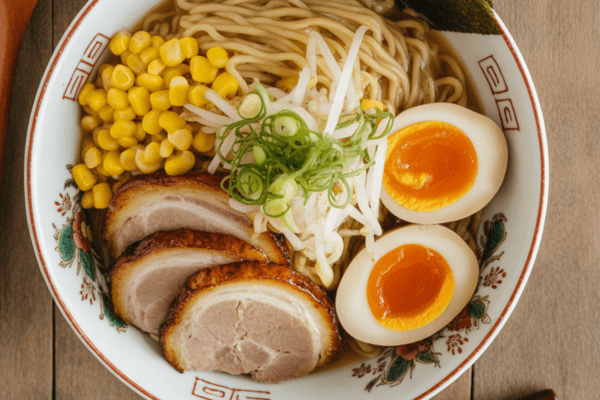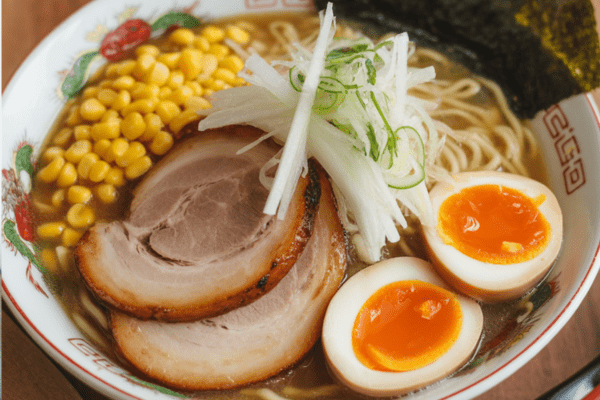If you love that deep, cozy, restaurant-style ramen but want to make it at home in under 30 minutes, this spicy miso ramen is for you. I’ve been making versions of this for years, especially on cool evenings when I want something hearty but not too heavy. The broth is savory and comforting, the noodles are bouncy, and you can top it with all sorts of goodies you have in the fridge.

This recipe is practical, quick, and a lot better than anything instant. I’ll show you how I do it at home, with tips you’d pick up if we were cooking together in my kitchen.
Why This Homemade Miso Ramen Is a Go-To in My House
I make this at least a few times every month, especially when my family wants “something special” but I don’t want to spend hours in the kitchen. The broth is rich and layered without needing to simmer all day. I love that it’s customizable—sometimes I go heavy on spice, other times I keep it mild so the kids can enjoy it.
It’s also one of those meals that feels like a treat without blowing the budget. Honestly, once you make this, you’ll wonder why you ever paid so much for a bowl out.
Building a Great Ramen Bowl at Home
A good ramen bowl has three parts: the broth, the noodles, and the toppings. Don’t overthink it—you can make it as simple or fancy as you like.
The Quick and Flavorful Broth
Most ramen shops simmer bones for hours to get that milky richness. At home, we cheat a bit. I use chicken broth as the base and build on it with five key ingredients that make it sing:
Miso
Miso is the star. I usually keep a couple of tubs in the fridge, one lighter, one darker. I prefer using a balanced miso here—neither too sweet nor too strong. The big tip? Don’t just scoop it in directly. I mix mine with a bit of warm broth to make sure it dissolves smoothly. That way you don’t get lumps.
Spicy Bean Paste
This is my secret for depth and heat. It has fermented, salty notes that make the broth more interesting. I adjust the amount based on who’s eating. When it’s just me and my wife, we like it spicier. For the kids, I tone it down or skip it entirely.
If I don’t have the bean paste on hand, I’ve been known to use a spoonful of Korean chili paste, though the flavor changes a bit. It’s not traditional but it works in a pinch.
Sesame Seeds and Sesame Oil
I love how nutty this makes the broth. If you can, toast your sesame seeds lightly in a dry pan before crushing them. It brings out so much more aroma. I keep a small mortar and pestle just for this. Sesame oil is strong, so I use just enough to give that fragrant finish without making the soup greasy.
Chicken Broth
Homemade is always best. I usually make stock on weekends with leftover bones and freeze it in batches. But I’m not above using store-bought if time is tight. Just taste before adding salt because boxed broth can be salty.
White Pepper
This is one of my favorite spices for soups. It adds heat without tasting like chili. I usually sprinkle a bit at the end and stir. It’s subtle but so good.

Tips to Make the Broth Shine
- Dissolve the miso completely so the broth stays smooth.
- Taste as you go—broth should be salty enough to stand up to the noodles but not overpowering.
- Simmer gently, don’t boil hard. You want the flavors to meld, not get harsh.
When I’m cooking with friends, I always tell them ramen broth is forgiving. Start with less salt or spice and adjust as you go. You can always add more.
Choosing the Noodles
Ramen noodles are their own thing—they’re firm, springy, and have a slight chew that holds up in broth.
Fresh Noodles
I prefer fresh noodles when I can find them. My local Asian market stocks them in the fridge section. They cook super fast—usually in about a minute or two.
If I’m planning ahead, I’ll grab extra and freeze them. They cook fine straight from frozen.
Dried Noodles
If you can’t get fresh, dried ramen noodles work well. I always keep a few packs in the pantry for emergencies. They’re a little less chewy but still satisfying.
My Tips for Cooking Ramen Noodles
- Use a big pot of water. Noodles need space to move.
- Don’t salt the water. The broth will be salty enough.
- Have everything else ready before you cook them. Once cooked, serve immediately so they don’t get soggy.
Nothing worse than overcooked, bloated noodles sitting in broth for ten minutes. I usually yell at my family to get to the table right as I’m straining the noodles.
Toppings That Make It Personal
This is the fun part. Honestly, the toppings make ramen your own. On weekends, I’ll sometimes make chashu pork the day before. Other times, I’ll just soft-boil a few eggs and call it a day.
Here are some toppings I use often:
- Soft-boiled eggs (soak in soy sauce for extra flavor)
- Braised pork belly (I make this when I want to impress)
- Corn kernels (kids love this)
- Green onions (always fresh)
- Nori sheets (gives a lovely sea-like aroma)
- Menma (seasoned bamboo shoots)
- Blanched greens (spinach or bok choy for color)
When I’m in a rush, I’ll just top it with sliced leftover roast chicken, some sautéed mushrooms, or even tofu. It’s incredibly flexible.
My Ramen Cooking Routine
If I know I’m making ramen, I often prep toppings a day ahead. For example, I’ll marinate eggs overnight so they get that rich, soy-infused flavor.
On busy weeknights, I keep it simple. Quick broth, fresh noodles, a jammy egg, a sprinkle of green onion, and a drizzle of sesame oil. Dinner is ready in 20 minutes.
Real-Life Serving Suggestions
I serve ramen in deep bowls so the broth stays hot longer. I’ll sometimes set out toppings buffet-style so everyone can customize their bowl.
This is one of those meals that makes dinner feel like an event without any fuss. Perfect for cool nights, movie dinners, or a casual weekend lunch.
How I Store Leftovers
The broth keeps in the fridge for 3–4 days or frozen for up to 2 months. I usually portion it in freezer containers so I can reheat just what I need.
I don’t store noodles in the broth—they’ll get mushy. I cook fresh noodles each time because they only take a minute or two. Leftover toppings like marinated eggs or braised pork keep well in the fridge for a few days.

A Few Questions I Get All the Time
Can I make it less spicy?
Absolutely. Just reduce or skip the bean paste. Sometimes I make a mild pot for the kids and add extra chili oil to mine.
Do I need sugar?
I add a bit of sugar to balance the saltiness of miso and the bean paste. Usually about a teaspoon, but taste and adjust.
Can I skip the sake?
You can, though I like the extra layer of flavor it brings. If you want to substitute, a splash of dry sherry or rice wine works well. But the soup is still good without it.
Final Thoughts
Making ramen at home is way easier than you think. Don’t worry about perfection. It’s about creating a bowl that’s warm, satisfying, and just the way you like it.
I hope you try this spicy miso ramen and make it your own. If you do, let me know what toppings you added or how you tweaked it. Cooking is always better when shared.
Spicy Miso Ramen

This miso ramen recipe brings together deep umami flavors in a silky broth that’s ready in under 30 minutes.
Ingredients
For the Broth:
- 2 cloves garlic, minced or pressed
- ½ teaspoon grated ginger
- 1 shallot, finely minced
- 1 tablespoon toasted sesame oil
- ¼ pound ground pork (or sub mushrooms or plant-based crumbles for vegetarian/vegan)
- 1 tablespoon sake
- 1 teaspoon spicy doubanjiang (chili bean paste)
- 3 tablespoons miso paste (avoid Saikyo and Hatcho for best results)
- 1 tablespoon sugar
- 1 tablespoon toasted white sesame seeds, lightly ground
- 4 cups chicken stock or vegetable stock
- ¼ teaspoon white pepper
- Salt to taste (up to 1 teaspoon kosher salt depending on broth)
For the Noodles:
- 2 servings fresh ramen noodles (10–12 oz total) or 6.3 oz dry noodles (use gluten-free ramen if needed)
Optional Toppings:
- Ramen egg (halved)
- Braised pork belly (chashu)
- Corn kernels (frozen or canned, drained)
- Blanched or spicy bean sprouts
- Nori (seaweed), cut into quarters
- Julienned long green onion (Shiraga Negi)
- Chopped scallions
Optional Condiments:
- Japanese chili oil (la-yu)
- Pickled red ginger
- Extra white pepper
Instructions
- Start by prepping the flavor base: mince the garlic and shallot, grate the ginger, and grind the toasted sesame seeds. Set everything aside for quick access once you begin cooking.
- Heat a medium pot over medium-low heat and add the toasted sesame oil. Once hot, sauté the garlic, ginger, and shallot until fragrant.
- Turn the heat to medium and stir in the ground pork. Cook until the pork is browned and no longer pink.
- Add the doubanjiang and miso, stirring quickly to combine with the meat—don’t let the miso burn. Stir in the ground sesame seeds and sugar until well mixed.
- Pour in the sake and chicken stock. Bring the mixture to a gentle simmer and let it bubble away for a few minutes.
- Taste the broth and season with salt and white pepper as needed, adjusting based on your stock’s saltiness. Cover and keep the broth on low heat while preparing the noodles.
- Cook the Noodles:Bring a large pot of unsalted water to a boil. While waiting, rinse your ramen noodles gently with your fingers to separate them.
- Once boiling, add the noodles and cook according to package directions—usually about 2 minutes for fresh, slightly longer for dry. Cook until al dente, about 15 seconds less than fully done for best texture.
- Warm your ramen bowls by filling them with hot water, then empty just before serving.
- Drain the noodles well using a mesh strainer—excess water can dilute the broth. Divide the noodles between your warmed bowls.
- Assemble and Serve:Ladle the hot miso broth over the noodles. Add your choice of toppings—soft ramen egg, chashu pork, blanched sprouts, corn, nori, scallions, and Shiraga Negi.
- Finish with a drizzle of chili oil or a pinch of pickled ginger if desired. Serve hot and enjoy immediately.
Nutrition Information
Yield
2Serving Size
1Amount Per Serving Calories 2279Total Fat 95gSaturated Fat 29gTrans Fat 0gUnsaturated Fat 57gCholesterol 514mgSodium 6583mgCarbohydrates 238gFiber 15gSugar 33gProtein 117g
Easy Shrimp Recipes.com, occasionally offers nutritional information for recipes contained on this site. This information is provided as a courtesy and is an estimate only. This information comes from online calculators. Although allchickenrecipes.com attempts to provide accurate nutritional information, these figures are only estimates.

